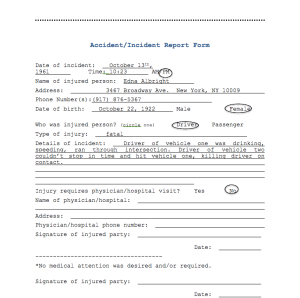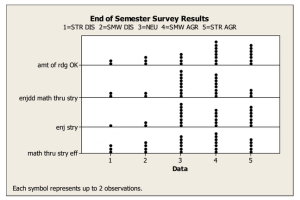This past spring, my department offered the opportunity for me to work with Andrea Nemeth and Mark Schilling, each, like myself, faculty members at California State University Northridge (CSUN), on an experimental math textbook for a pre-statistics course at CSUN. I accepted the offer, as the project sounded creative and fun, and it came with a small stipend. I was surprised how the project opened up new paths of thinking and provided new avenues of research. This short write-up is to share my experience and preliminary thoughts on how this project, even at its early stages, can open up new possible lines of inquiry and add to the conversation of humanities advocacy in general.
Andrea spearheaded the project as Assistant Director of the Developmental Math Program. When Andrea, Mark and I began brainstorming the project in April, Andrea had a basic outline of what she wanted: a narrative textbook that contained math questions. She and Mark threw around several ideas, including the idea of a road trip. My job was to write the narrative. I began writing a story that was in the genre of novels with which I was currently reading.
So, I wrote a murder-mystery novel. Mark and Andrea worked rigorously writing the math part of the book, which took the form of word problems that incorporated the content of the story (in oftentimes very creative ways), and we each revised and edited each other’s work as we wrote. By the end of summer, our rough “first edition” had been completed. It is currently being used in two sections of M096 at CSUN by over fifty students.
I’ll do my best to explain what the book is about, and above I’ve included some screenshots, but everything is still in progress. It is a long-term idea in its first stages, but even at this point our process is worth discussing, if only in general terms.
Here is the basic plot of the story: four college students embark on a summer road trip at the behest of their math professor. He initially provides them with a vague outline of their trip, and, along the way, communicates with them via email to provide directions for their next stop. At each location, the students learn about and answer math questions that involve aspects of the area. Once answered, they earn some money that keeps them going. We tried to make the narrative as rooted in reality as possible, using real places, names, and even a mock crime report (below) and real newspaper clipping with photoshopped article (one of the clues to the mystery). The story also tries to incorporate many aspects of the country’s natural landscape. At one point, the students visit Zion National Park, for instance. They walk real trails, camp at a real campground, and sightsee some of the area’s natural formations. Throughout this part of the journey, they learn about Zion’s beautiful, but extreme trails, the Grand Canyon, and other natural wonders of the West.
Ultimately, the students realize this trip was not solely about learning math and seeing the country. The professor has another agenda for sending them on this trip: his aunt passed away suddenly decades ago, and he has not let go of the idea that her death could have been a murder. As the professor directs them where to go, the students uncover mysterious aspects about the circumstances of her death, ultimately involving themselves so deeply that they take actions to solve the mystery on their own. When they return, they are changed; they have a better understanding of both themselves and the country they’ve just travelled.
The book is filled with mathematical tricks, tips, and clues, along with challenging word problems that cover several math topics, including Algebra (linear equalities, exponents, quadratic equations, graphing linear equalities and quadratic functions) and Statistics (population, parameter, sample, statistic, scatterplots, normal distribution, sample mean, median and mode, the idea of inference, and standard deviation), among others. There are also discussion questions and plenty of opportunities pedagogically for reading comprehension, even character analysis or plot analysis. Throughout the story, the reader sees the students challenge themselves, deal with tough situations, fall in love, recognize nature, and even try to understand the subtleties of their own self-defined identities as they get to know each other.
Throughout this semester, we have been surveying and observing the students. Our preliminary findings are positive: only 8 out of the 53 didn’t initially like the idea of learning math through a narrative, with most of those 8 being much less likely to read for pleasure than the others. One student even described the how the story “makes you want to keep going and see what happens at the end.” Words like “interesting,” “interactive,” “fun” and “exciting” were commonly part of responses to the question: “Do you like the idea of learning math through a story?” Some have even confided that this is the only piece of fiction they’ve read all year. We are still waiting for the end of the semester surveys to take place, and it will be interesting to see if the story helped them learn the material, not just enjoy it. We realize this query may take several semesters to answer in any reliable way.
Although the purpose of this project specifically is to produce an effective math textbook, I wonder what implications this type of book would have for the humanities or humanities advocacy. Our group asks if this story could cause a difficult experience (learning math, or any other subject) to become more pleasurable; I wonder if this might, in turn, cause students to find reading stories in general more pleasurable. Moreover, if discovering a story in an unexpected place, like a math textbook, causes the students to enjoy reading the textbook more than they would have otherwise, could this cause them to read more on their own, or at least consider it? Also, if the students associate with a character in the story, does it strengthen their learning experience? If any of these questions prove to be true, this project could also be a way of introducing and discovering humanities materials, including newly digitized artifacts, manuscripts, museums, authors, to students or the public. There will be more to come in the coming months, but I welcome any comments, suggestions, or thoughts on this project.
Update (January 18, 2014): I am happy to report that the average passing rate for the Fall 2013 courses that used the book was 70%–up 10% from the previous average of 60%. Also, overall, the end-of-semester surveys report that the majority of students enjoyed learning math through a story. Below is a graph outlining these results:

1) Amount of reading ok; 2) Enjoyed learning math through a story; 3) Enjoyed story; 4) Learning math through a story was effective. (on a scale of 1-5, Strongly Disagree to Strongly Agree)
More to come as we adjust the surveys, textbook, and course instruction this semester.

[…] Math Book Project–Beginnings […]